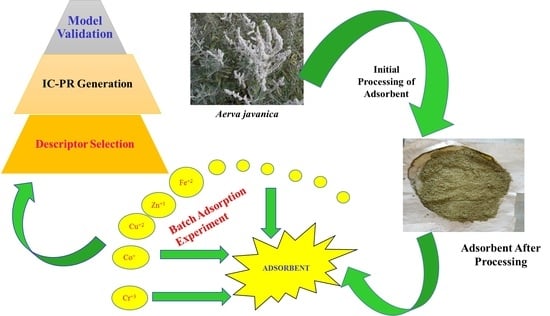Development of Ion Character Property Relationship (IC-PR) for Removal of 13-Metal Ions by Employing a Novel Green Adsorbent Aerva javanica
Abstract
1. Introduction
2. Results and Discussion
2.1. Characterization of Sorbents
2.1.1. Fourier-Transform Infrared Spectroscopy
2.1.2. Batch Adsorption for Parameters Optimization
2.1.3. IC-PR of Metal Ions with Aerva javanica as Adsorbent
2.1.4. Adsorption Capacity of Aerva javanica through Langmuir and Freundlich Isotherm
2.1.5. Model Validation
3. Materials and Methods
3.1. Materials
3.2. Chemicals
3.3. Characterization of Sorbent
3.4. Fourier-Transform Infrared Spectroscopy (FTIR)
3.5. Parameter Optimization by Batch Adsorption Experiment
3.6. Adsorption Study
3.7. Selection of Descriptors
3.8. Ion Character Property Relationship (IC-PR)
3.9. Regression Equation
| Symbol | Properties | Ca2+ | Cr3+ | Co2+ | Cu2+ | Cd2+ | K1+ | Mg2+ | Mn2+ | Na1+ | Ni2+ | Pb2+ | Zn2+ | Fe2+ |
|---|---|---|---|---|---|---|---|---|---|---|---|---|---|---|
| X1 | Atomic Number | 20 | 24 | 27 | 29 | 48 | 19 | 12 | 25 | 11 | 28 | 82 | 30 | 26 |
| X2 | Atomic Weight | 40.07 | 51.99 | 58.93 | 63.54 | 112.41 | 39.09 | 24.3 | 54.93 | 22.98 | 58.69 | 207.2 | 65.39 | 55.84 |
| X3 | Atomic Radius (Å) | 1.92 | 1.25 | 1.25 | 1.35 | 1.48 | 2.27 | 1.6 | 1.37 | 1.86 | 1.25 | 1.54 | 1.31 | 1.24 |
| X4 | Oxidation State | 2 | 3 | 2 | 2 | 2 | 1 | 2 | 2 | 1 | 2 | 2 | 2 | 2 |
| X5 | Electronegativity | 1 | 1.6 | 1.8 | 1.9 | 1.7 | 0.8 | 1.2 | 1.5 | 0.9 | 1.8 | 1.9 | 1.6 | 1.8 |
| X6 | Covalent Radius (Å) | 1.74 | 1.18 | 1.16 | 1.17 | 1.48 | 2.03 | 1.36 | 1.17 | 1.54 | 1.15 | 1.17 | 1.25 | 1.17 |
| X7 | Melting Point (°C) | 839 | 1857 | 1495 | 1083 | 321 | 63 | 649 | 1244 | 98 | 1453 | 1083 | 419 | 1535 |
| X8 | Boiling Point (°C) | 1484 | 2672 | 2870 | 2567 | 765 | 760 | 1090 | 1962 | 883 | 2732 | 2567 | 907 | 2750 |
| X9 | Ionic Radius (Å) | 0.99 | 0.52 | 0.75 | 0.73 | 0.97 | 1.38 | 0.72 | 0.46 | 1.02 | 0.69 | 1.19 | 0.74 | 0.65 |
| X10 | Ionization Energy (kj/mol) | 590 | 653 | 757 | 745 | 866 | 418 | 736 | 716 | 489 | 736 | 804 | 904 | 762 |
| X11 | Crystal Radius (Å) | 1.14 | 0.76 | 0.54 | 0.71 | 0.92 | 1.52 | 0.86 | 0.81 | 1.16 | 0.7 | 1.49 | 0.74 | 0.69 |
| X12 | Electron Affinity (kj/mol) | 2.4 | 64.3 | 63.7 | 118.4 | 0 | 48.4 | 0 | 0 | 53 | 112 | 35 | 0 | 15.7 |
| X13 | Atomic Volume (cm3/mol) | 25.97 | 7.23 | 6.7 | 7.1 | 13.1 | 45.36 | 0 | 7.39 | 23.68 | 6.6 | 18.27 | 9.2 | 7.1 |
| X14 | Density (g cm−3) | 1.55 | 7.19 | 8.9 | 8.96 | 8.65 | 0.86 | 1.74 | 7.43 | 0.97 | 8.9 | 11.4 | 7.14 | 7.86 |
| X15 | Atomic Radius/Atomic Weight | 0.048 | 0.024 | 0.021 | 0.021 | 0.013 | 0.058 | 0.065 | 0.025 | 0.08 | 0.02 | 0.007 | 0.02 | 0.022 |
| X16 | Ion Charge | 1.04 | 2.4 | 1.6 | 1.48 | 1.35 | 0.44 | 1.25 | 1.45 | 0.53 | 1.6 | 1.29 | 1.52 | 1.61 |
| X17 | Ion Charge/(Atomic Radius)2 | 0.54 | 1.92 | 1.28 | 1.09 | 0.91 | 0.19 | 0.78 | 1.06 | 0.28 | 1.28 | 0.84 | 1.16 | 1.3 |
| X18 | Standard Reduction Potential (V) | −2.87 | −0.74 | 0 | 0.34 | −0.4 | −2.93 | −2.37 | 0 | −2.71 | −0.25 | −0.13 | −0.76 | −0.44 |
| X19 | (Atomic Radius)2 (Å) | 3.68 | 1.56 | 1.56 | 1.82 | 2.19 | 5.15 | 2.56 | 1.87 | 3.45 | 1.56 | 2.37 | 1.71 | 1.53 |
| X20 | Cationic Polarizing Power | 2.08 | 7.2 | 3.2 | 2.96 | 2.7 | 0.44 | 2.5 | 2.91 | 0.53 | 3.2 | 2.59 | 3.05 | 3.22 |
| X21 | Covalent Index | 1.92 | 3.2 | 4.05 | 4.87 | 4.27 | 1.45 | 2.3 | 3.08 | 1.5 | 4.05 | 5.55 | 3.35 | 4.01 |
4. Conclusions
Author Contributions
Funding
Institutional Review Board Statement
Informed Consent Statement
Data Availability Statement
Acknowledgments
Conflicts of Interest
References
- Muhammad, S.; Usman, Q.A. Heavy metal contamination in water of Indus River and its tributaries, Northern Pakistan: Evaluation for potential risk and source apportionment. Toxin Rev. 2022, 41, 380–388. [Google Scholar] [CrossRef]
- Ali, S.; Abbas, Z.; Rizwan, M.; Zaheer, I.E.; Yavaş, İ.; Ünay, A.; Abdel-Daim, M.M.; Bin-Jumah, M.; Hasanuzzaman, M.; Kalderis, D. Application of floating aquatic plants in phytoremediation of heavy metals polluted water: A review. Sustainability 2020, 12, 1927. [Google Scholar] [CrossRef]
- Bilos, C.; Colombo, J.C.; Skorupka, C.N.; Presa, M.J.R. Sources, distribution and variability of airborne trace metals in La Plata City area, Argentina. Environ. Pollut. 2001, 111, 149–158. [Google Scholar] [CrossRef]
- Koch, M.; Rotard, W. On the contribution of background sources to the heavy metal content of municipal sewage sludge. Water Sci. Technol. 2001, 43, 67–74. [Google Scholar] [CrossRef] [PubMed]
- Yargholi, B.; Azimi, A.A.; Baghvand, A.; Liaghat, A.M.; Fardi, G.A. Investigation of cadmium absorption and accumulation in different parts of some vegetables. Am.-Eurasian J. Agric. Environ. Sci. 2008, 3, 357–364. [Google Scholar]
- Al Naggar, Y.; Khalil, M.S.; Ghorab, M.A. Environmental pollution by heavy metals in the aquatic ecosystems of Egypt. Open Acc. J. Toxicol 2018, 3, 555603. [Google Scholar]
- Maleva, M.G.; Nekrasova, G.F.; Bezel, V.S. The response of hydrophytes to environmental pollution with heavy metals. Russ. J. Ecol. 2004, 35, 230–235. [Google Scholar] [CrossRef]
- Afkhami, A.; Madrakian, T.; Amini, A.; Karimi, Z. Effect of the impregnation of carbon cloth with ethylenediaminetetraacetic acid on its adsorption capacity for the adsorption of several metal ions. J. Hazard. Mater. 2008, 150, 408–412. [Google Scholar] [CrossRef]
- Ku, Y.; Jung, I.-L. Photocatalytic reduction of Cr(VI) in aqueous solutions by UV irradiation with the presence of titanium dioxide. Water Res. 2001, 35, 135–142. [Google Scholar] [CrossRef]
- Saravanan, A.; Kumar, P.S.; Jeevanantham, S.; Karishma, S.; Tajsabreen, B.; Yaashikaa, P.R.; Reshma, B. Effective water/wastewater treatment methodologies for toxic pollutants removal: Processes and applications towards sustainable development. Chemosphere 2021, 280, 130595. [Google Scholar] [CrossRef]
- Katheresan, V.; Kansedo, J.; Lau, S.Y. Efficiency of various recent wastewater dye removal methods: A review. J. Environ. Chem. Eng. 2018, 6, 4676–4697. [Google Scholar] [CrossRef]
- Subramani, A.; Jacangelo, J.G. Emerging desalination technologies for water treatment: A critical review. Water Res. 2015, 75, 164–187. [Google Scholar] [CrossRef] [PubMed]
- Hao, X.; Hua, G.; Jiangtao, F.; Dan, W.; Zhengwei, L.; Yu, W.; Wei, Y. electrochemical oxidation combined with adsorption: A novel route for low concentration organic wastewater treatment. Int. J. Electrochem. Sci. 2019, 14, 8110–8120. [Google Scholar] [CrossRef]
- Abd El-Lateef, H.M.; Ali, M.M.K.; Saleh, M.M. Adsorption and removal of cationic and anionic surfactants using zero-valent iron nanoparticles. J. Mol. Liq. 2018, 268, 497–505. [Google Scholar] [CrossRef]
- Okpara, O.G.; Ogbeide, O.M.; Ike, O.C.; Menechukwu, K.C.; Ejike, E.C. Optimum isotherm by linear and nonlinear regression methods for lead (II) ions adsorption from aqueous solutions using synthesized coconut shell–activated carbon (SCSAC). Toxin Rev. 2021, 40, 901–914. [Google Scholar] [CrossRef]
- Jusoh, A.; Shiung, L.S.; Ali, N.; Noor, M. A simulation study of the removal efficiency of granular activated carbon on cadmium and lead. Desalination 2007, 206, 9–16. [Google Scholar] [CrossRef]
- Kang, G.-d.; Cao, Y.-m. Development of antifouling reverse osmosis membranes for water treatment: A review. Water Res. 2012, 46, 584–600. [Google Scholar] [CrossRef]
- Erses, A.S.; Fazal, M.A.; Onay, T.T.; Craig, W.H. Determination of solid waste sorption capacity for selected heavy metals in landfills. J. Hazard. Mater. 2005, 121, 223–232. [Google Scholar]
- Abdul, A.; Aberuagba, F. Comparative study of the adsorption of phosphate by activated charcoal from corncobs, groundnut shells and rice-husks. Aust. J. Technol. 2005, 9, 59–63. [Google Scholar]
- Park, H.G.; Kim, T.W.; Chae, M.Y.; Yoo, I.-K. Activated carbon-containing alginate adsorbent for the simultaneous removal of heavy metals and toxic organics. Process Biochem. 2007, 42, 1371–1377. [Google Scholar] [CrossRef]
- Prakash, N.; Manikandan, S.A.; Govindarajan, L.; Vijayagopal, V. Prediction of biosorption efficiency for the removal of copper(II) using artificial neural networks. J. Hazard. Mater. 2008, 152, 1268–1275. [Google Scholar] [CrossRef] [PubMed]
- Tropsha, A.; Gramatica, P.; Gombar, V.K. The importance of being earnest: Validation is the absolute essential for successful application and interpretation of QSPR models. QSAR Comb. Sci. 2003, 22, 69–77. [Google Scholar] [CrossRef]
- Le, T.; Epa, V.C.; Burden, F.R.; Winkler, D.A. Quantitative Structure–Property Relationship Modeling of Diverse Materials Properties. Chem. Rev. 2012, 112, 2889–2919. [Google Scholar] [CrossRef] [PubMed]
- Wang, Z.; Xu, W.; Jie, F.; Zhao, Z.; Zhou, K.; Liu, H. The selective adsorption performance and mechanism of multiwall magnetic carbon nanotubes for heavy metals in wastewater. Sci. Rep. 2021, 11, 16878. [Google Scholar] [CrossRef] [PubMed]
- Rao, B.H.; Asolekar, S.R. QSAR models to predict effect of ionic strength on sorption of chlorinated benzenes and phenols at sediment–water interface. Water Res. 2001, 35, 3391–3401. [Google Scholar] [CrossRef]
- Can, C.; Jianlong, W.J.C. Correlating metal ionic characteristics with biosorption capacity using QSAR model. Chemosphere 2007, 69, 1610–1616. [Google Scholar] [CrossRef]
- Belskaya, O.B.; Lavrenov, A.V.; Danilova, I.G.; Kazakov, M.O.; Mironenko, R.M.; Likholobov, V.A. FTIR Spectroscopy of Adsorbed Probe Molecules for Analyzing the Surface Properties of Supported Pt (Pd) Catalysts; IntechOpen: Licko-Senjska, Croatia, 2012. [Google Scholar]
- Salame, I.I.; Bandosz, T.J. Surface chemistry of activated carbons: Combining the results of temperature-programmed desorption, Boehm, and potentiometric titrations. J. Colloid Interface Sci. 2001, 240, 252–258. [Google Scholar] [CrossRef]
- Darweesh, H.H.M.; El-Suoud, M.R.A. Setting, hardening and mechanical properties of some cement/agrowaste composites-Part I. Am. J. Min. Metall. 2014, 2, 32–40. [Google Scholar]
- Draman, S.F.; Mohd, N.; Wahab, N.H.; Zulkfli, N.S.; Bakar, N.F. Adsorption of lead (II) ions in aqueous solution using selected agro-waste. ARPN J. Eng. Appl. Sci. 2015, 10, 297–300. [Google Scholar]
- Fletcher, A.J.; Uygur, Y.; Thomas, K.M. Role of surface functional groups in the adsorption kinetics of water vapor on microporous activated carbons. J. Phys. Chem. C 2007, 111, 8349–8359. [Google Scholar] [CrossRef]
- Ferahtia, A.; Halilat, M.T.; Mimeche, F.; Bensaci, E. Surface Water Quality Assessment in Semi-Arid Region (El Hodna Watershed, Algeria) Based on Water Quality Index (WQI). 2021. Available online: https://www.researchgate.net/publication/350567414_SURFACE_WATER_QUALITY_ASSESSMENT_IN_SEMI-ARID_REGION_EL_HODNA_WATERSHED_ALGERIA_BASED_ON_WATER_QUALITY_INDEX_WQI (accessed on 21 January 2021).
- Putra, W.P.; Kamari, A.; Yusoff, S.N.M.; Ishak, C.F.; Mohamed, A.; Hashim, N.; Isa, I.M. Biosorption of Cu (II), Pb (II) and Zn (II) ions from aqueous solutions using selected waste materials: Adsorption and characterisation studies. J. Encapsulation Adsorpt. Sci. 2014, 2014, 25–35. [Google Scholar] [CrossRef]
- Ai, T.; Jiang, X.; Yu, H.; Xu, H.; Pan, D.; Liu, Q.; Chen, D.; Li, J. Equilibrium, kinetic and mechanism studies on the biosorption of Cu2+ and Ni2+ by sulfur-modified bamboo powder. Korean J. Chem. Eng. 2015, 32, 342–349. [Google Scholar] [CrossRef]
- Malandrino, M.; Abollino, O.; Giacomino, A.; Aceto, M.; Mentasti, E. Adsorption of heavy metals on vermiculite: Influence of pH and organic ligands. J. Colloid Interface Sci. 2006, 299, 537–546. [Google Scholar] [CrossRef]
- Johnson, B.B. Effect of pH, temperature, and concentration on the adsorption of cadmium on goethite. Environ. Sci. Technol. 1990, 24, 112–118. [Google Scholar] [CrossRef]
- Teka, T.; Enyew, S. Study on effect of different parameters on adsorption efficiency of low cost activated orange peels for the removal of methylene blue dye. Int. J. Innov. Sci. Res. 2014, 8, 106–111. [Google Scholar]
- Ishola, T.K.; Olanipekun, T.O.; Bolarinwa, T.O.; Oladeji, D.R.; Abubakar, A. Complex Equilibria and Distribution of Metal (II) Ions with Biologically Active Chelating Agents in Aqueous and Aqueous-organic Media. Chem. Sci. Int. J. 2021, 30, 25–38. [Google Scholar] [CrossRef]
- Batool, F.; Iqbal, S.; Akbar, J. Impact of metal ionic characteristics on adsorption potential of Ficus carica leaves using QSPR modeling. J. Environ. Sci. Health Part B 2018, 53, 276–281. [Google Scholar] [CrossRef]
- Shahbazi, A.; Younesi, H.; Badiei, A. Functionalized SBA-15 mesoporous silica by melamine-based dendrimer amines for adsorptive characteristics of Pb(II), Cu(II) and Cd(II) heavy metal ions in batch and fixed bed column. Chem. Eng. J. 2011, 168, 505–518. [Google Scholar] [CrossRef]
- Verhoef, R.W.; Asscher, M. The work function of adsorbed alkalis on metals revisited: A coverage-dependent polarizability approach. Surf. Sci. 1997, 391, 11–18. [Google Scholar] [CrossRef]
- Perry, J.J.; Teich-McGoldrick, S.L.; Meek, S.T.; Greathouse, J.A.; Haranczyk, M.; Allendorf, M.D. Noble gas adsorption in metal–organic frameworks containing open metal sites. J. Phys. Chem. C 2014, 118, 11685–11698. [Google Scholar] [CrossRef]
- LeVan, M.D.; Carta, G.; Yon, C.M. Adsorption and ion exchange. Energy 1997, 16, 17. [Google Scholar]
- Srivastava, V.C.; Mall, I.D.; Mishra, I.M. Characterization of mesoporous rice husk ash (RHA) and adsorption kinetics of metal ions from aqueous solution onto RHA. J. Hazard. Mater. 2006, 134, 257–267. [Google Scholar] [CrossRef] [PubMed]
- Horie, M.; Fujita, K.; Kato, H.; Endoh, S.; Nishio, K.; Komaba, L.K.; Nakamura, A.; Miyauchi, A.; Kinugasa, S.; Hagihara, Y. Association of the physical and chemical properties and the cytotoxicity of metal oxidenanoparticles: Metal ion release, adsorption ability and specific surface area. Metallomics 2012, 4, 350–360. [Google Scholar] [CrossRef] [PubMed]
- Stafiej, A.; Pyrzynska, K. Adsorption of heavy metal ions with carbon nanotubes. Sep. Purif. Technol. 2007, 58, 49–52. [Google Scholar] [CrossRef]
- Ghorbel-Abid, I.; Trabelsi-Ayadi, M. Competitive adsorption of heavy metals on local landfill clay. Arab. J. Chem. 2015, 8, 25–31. [Google Scholar] [CrossRef]
- Motsi, T.; Rowson, N.A.; Simmons, M.J.H. Adsorption of heavy metals from acid mine drainage by natural zeolite. Int. J. Miner. Process. 2009, 92, 42–48. [Google Scholar] [CrossRef]
- Thirumavalavan, M.; Lai, Y.-L.; Lin, L.-C.; Lee, J.-F. Cellulose-based native and surface modified fruit peels for the adsorption of heavy metal ions from aqueous solution: Langmuir adsorption isotherms. J. Chem. Eng. Data 2010, 55, 1186–1192. [Google Scholar] [CrossRef]
- Altın, O.; Özbelge, H.Ö.; Doğu, T. Use of general purpose adsorption isotherms for heavy metal–clay mineral interactions. J. Colloid Interface Sci. 1998, 198, 130–140. [Google Scholar] [CrossRef]
- Chiban, M.; Soudani, A.; Sinan, F.; Persin, M. Single, binary and multi-component adsorption of some anions and heavy metals on environmentally friendly Carpobrotus edulis plant. Colloids Surf. B Biointerfaces 2011, 82, 267–276. [Google Scholar] [CrossRef]
- Roy, K.; Mitra, I.; Kar, S.; Ojha, P.K.; Das, R.N.; Kabir, H. Comparative studies on some metrics for external validation of QSPR models. J. Chem. Inf. Model. 2012, 52, 396–408. [Google Scholar] [CrossRef]
- Solov’Ev, V.P.; Kireeva, N.; Tsivadze, A.Y.; Varnek, A. QSPR ensemble modelling of alkaline-earth metal complexation. J. Incl. Phenom. Macrocycl. Chem. 2013, 76, 159–171. [Google Scholar] [CrossRef]
- Gayathri, R.; Gopinath, K.P.; Kumar, P.S. Adsorptive separation of toxic metals from aquatic environment using agro waste biochar: Application in electroplating industrial wastewater. Chemosphere 2021, 262, 128031. [Google Scholar] [CrossRef] [PubMed]
- Mittal, A.; Kurup, L.; Mittal, J. Freundlich and Langmuir adsorption isotherms and kinetics for the removal of Tartrazine from aqueous solutions using hen feathers. J. Hazard. Mater. 2007, 146, 243–248. [Google Scholar] [CrossRef]
- Kovalishyn, V.; Abramenko, N.; Kopernyk, I.; Charochkina, L.; Metelytsia, L.; Tetko, I.V.; Peijnenburg, W.; Kustov, L. Modelling the toxicity of a large set of metal and metal oxide nanoparticles using the OCHEM platform. Food Chem. Toxicol. 2018, 112, 507–517. [Google Scholar] [CrossRef] [PubMed]
- Wolterbeek, H.T.; Verburg, T.G. Predicting metal toxicity revisited: General properties vs. specific effects. Sci. Total Environ. 2001, 279, 87–115. [Google Scholar] [CrossRef]
- McCloskey, J.T.; Newman, M.C.; Clark, S.B.J.E.T.; Journal, C.A.I. Predicting the relative toxicity of metal ions using ion characteristics: Microtox® bioluminescence assay. Environ. Toxicol. Chem. Int. J. 1996, 15, 1730–1737. [Google Scholar] [CrossRef]
- Miranda, L.S.; Ayoko, G.A.; Egodawatta, P.; Goonetilleke, A. Adsorption-desorption behavior of heavy metals in aquatic environments: Influence of sediment, water and metal ionic properties. J. Hazard. Mater. 2022, 421, 126743. [Google Scholar] [CrossRef]
- Zamil, S.S.; Ahmad, S.; Choi, M.H.; Park, J.Y.; Yoon, S.C. Correlating metal ionic characteristics with biosorption capacity of Staphylococcus saprophyticus BMSZ711 using QICAR model. Bioresour. Technol. 2009, 100, 1895–1902. [Google Scholar] [CrossRef]
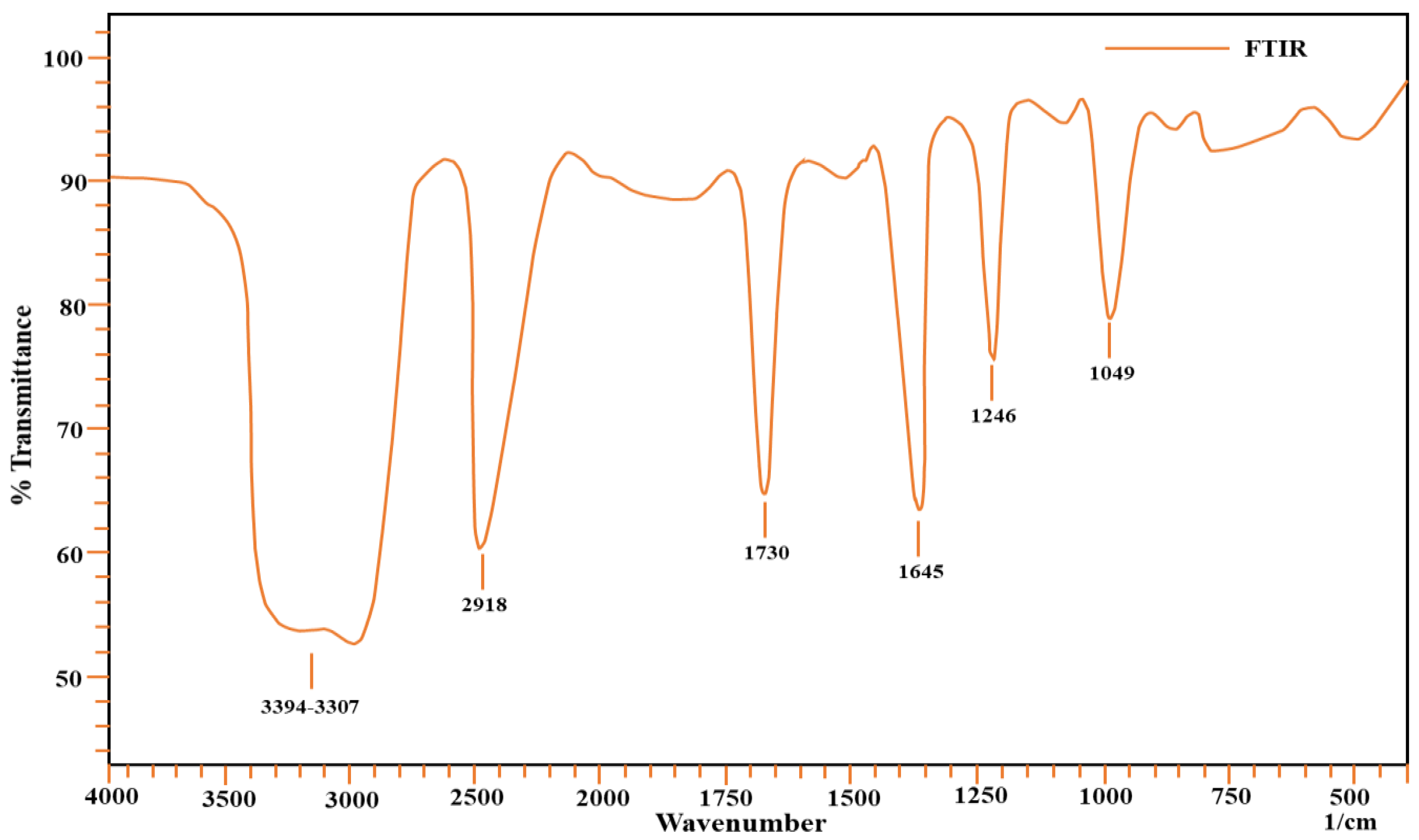
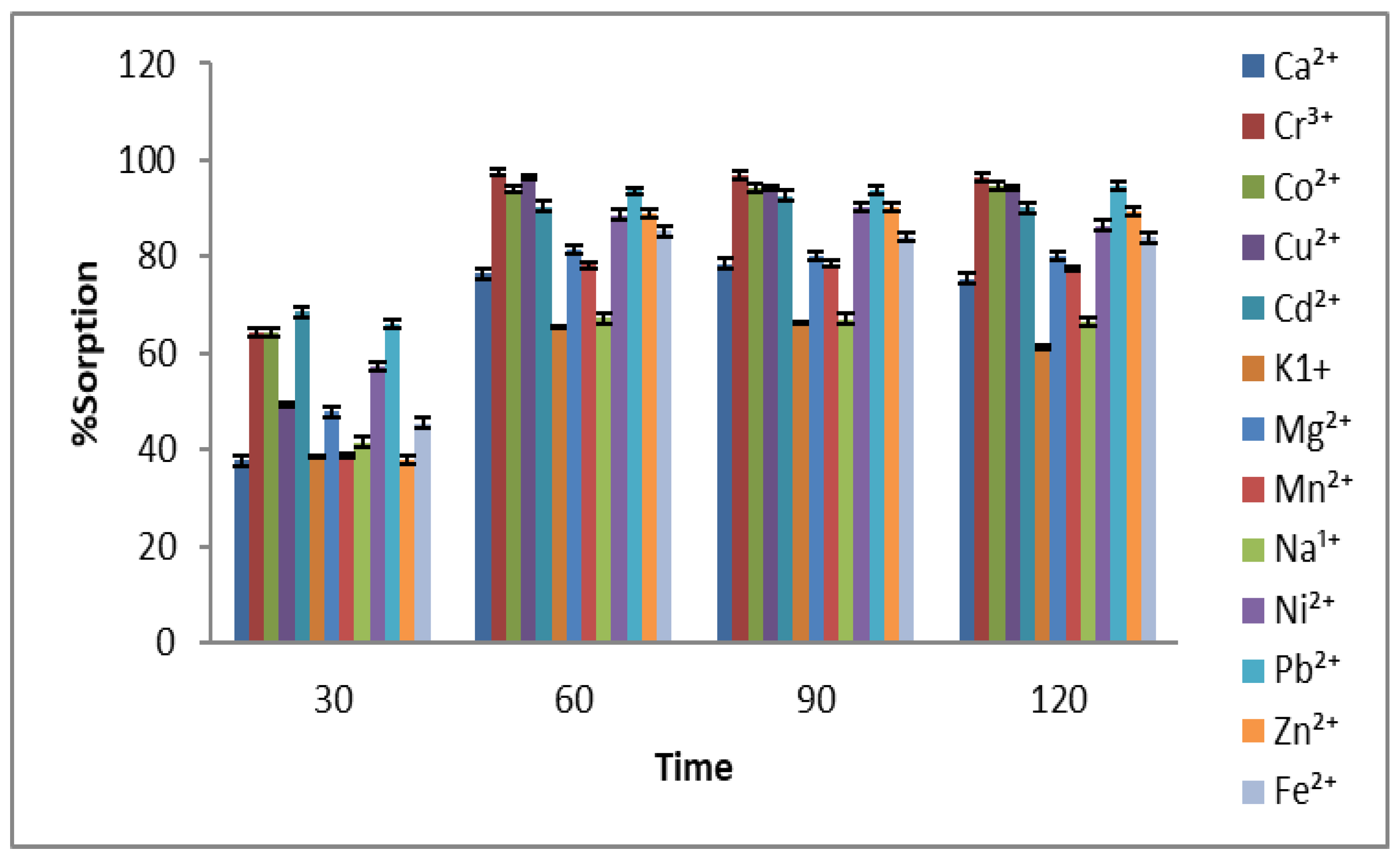
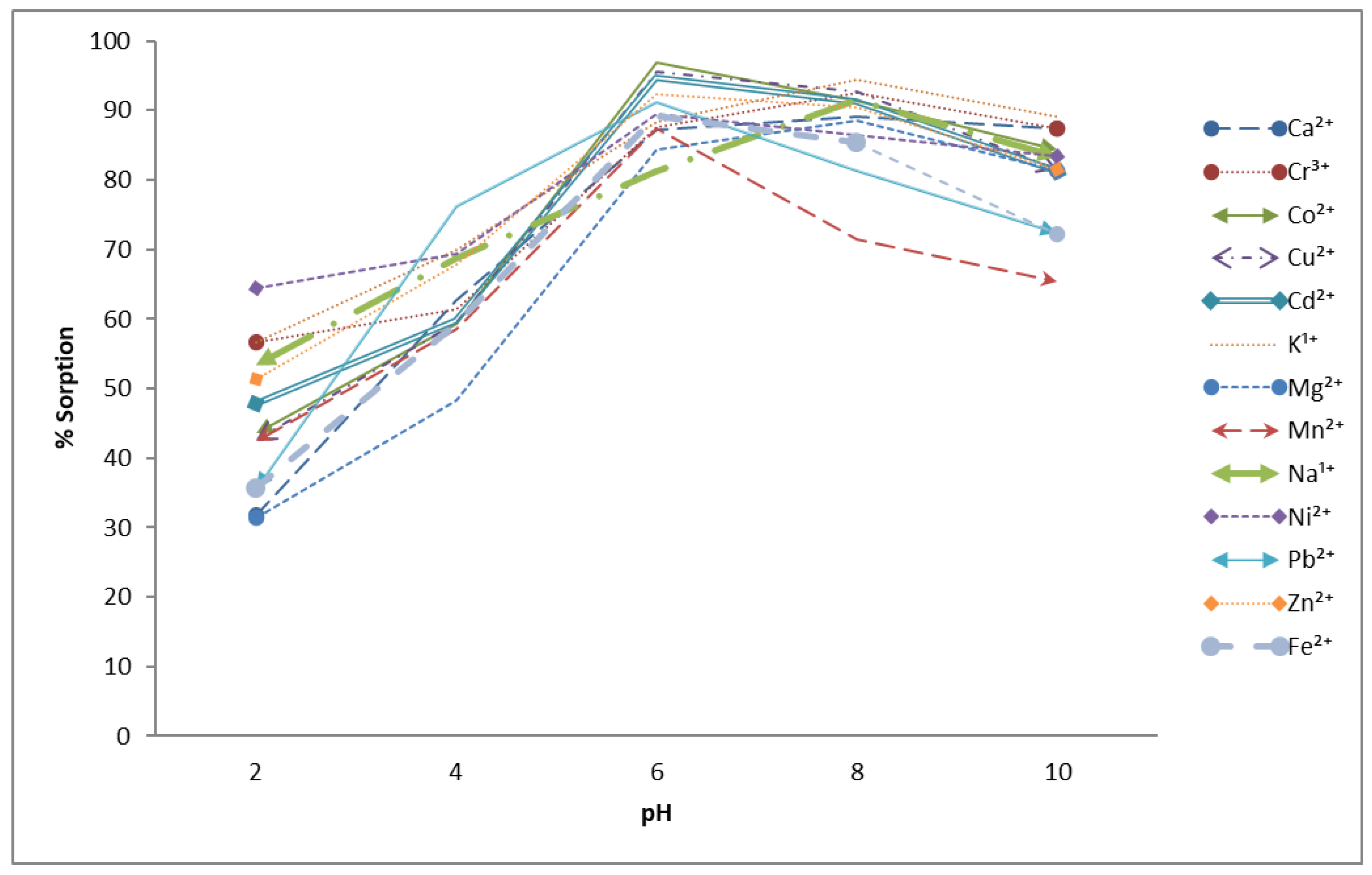
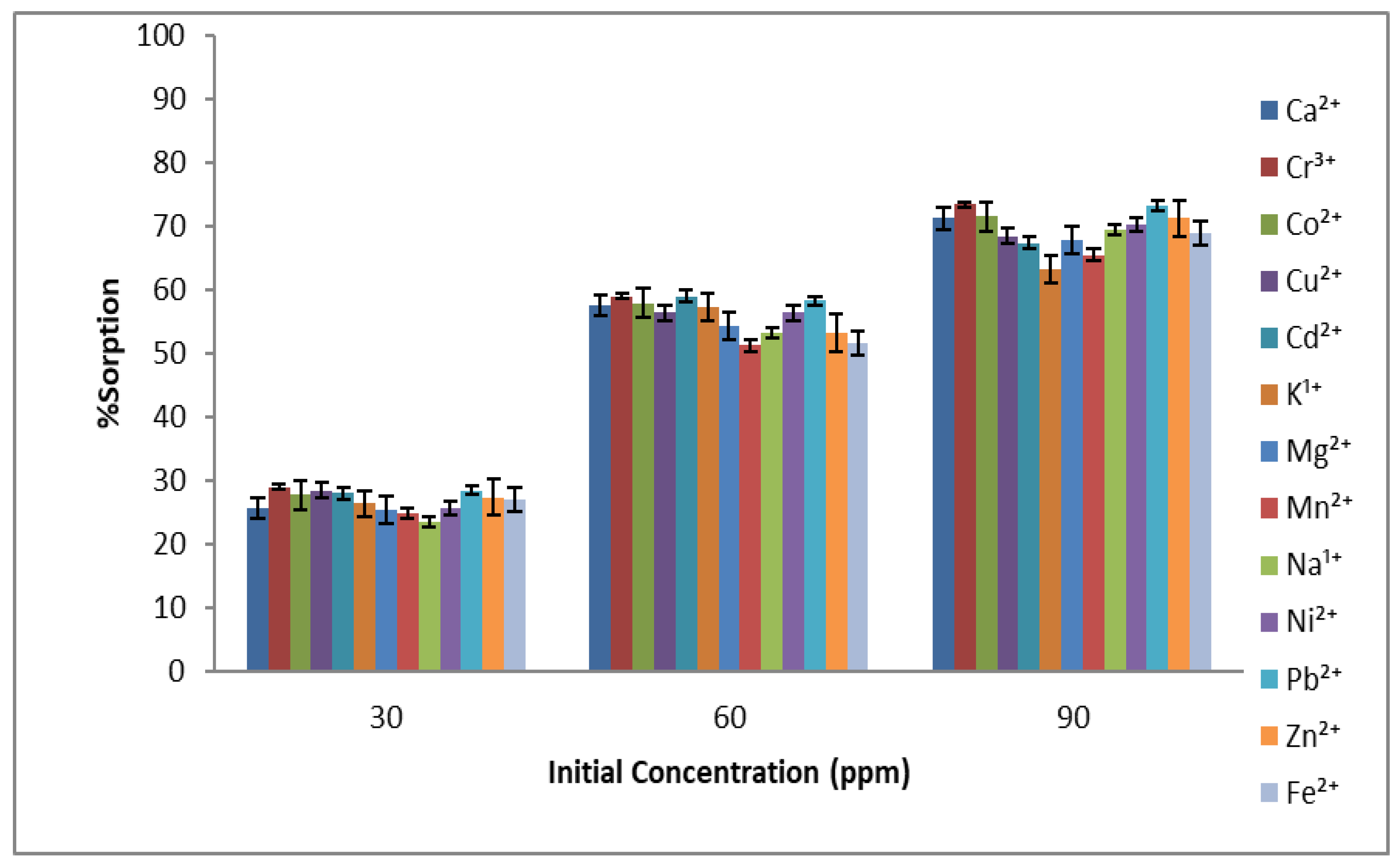
| Sr. No | Model Equation | R | R2 | R2 Adjusted | p-Value | F-Value | Standard Error |
|---|---|---|---|---|---|---|---|
| 1 | 83.48 + 0.2084 X1 | 0.7082 | 0.5016 | 0.4563 | 0.0067 | 11.0739 | 3.9694 |
| 2 | 84.44 + 0.0781 X2 | 0.6958 | 0.4842 | 0.4373 | 0.0082 | 10.3277 | 4.0382 |
| 3 | 105.94 − 10.80 X3 | 0.6445 | 0.4154 | 0.3623 | 0.0173 | 7.8189 | 4.2990 |
| 4 | 76.52 + 6.79 X4 | 0.6226 | 0.3877 | 0.3320 | 0.0230 | 6.9655 | 4.3999 |
| 5 | 71.86 + 11.81 X5 | 0.8592 | 0.7383 | 0.7146 | 0.0002 | 31.0478 | 2.8760 |
| 6 | 106.87 − 12.79 X6 | 0.6549 | 0.4289 | 0.3771 | 0.0151 | 8.2643 | 4.2490 |
| 7 | 84.17 + 0.0058 X7 | 0.6318 | 0.3991 | 0.3445 | 0.0205 | 7.3080 | 4.3585 |
| 8 | 81.73 + 0.0042 X8 | 0.6929 | 0.4801 | 0.4329 | 0.0086 | 10.1604 | 4.0541 |
| 9 | 93.6887 − 4.9411 X9 | 0.2424 | 0.0588 | −0.0267 | 0.4247 | 0.6872 | 5.4552 |
| 10 | 73.46 + 0.0228 X10 | 0.5871 | 0.3448 | 0.2852 | 0.0348 | 5.7887 | 4.5515 |
| 11 | 93.8452 − 4.6011 X11 | 0.2650 | 0.0702 | −0.0142 | 0.3815 | 0.8309 | 5.4219 |
| 12 | 88.3185 + 0.0320 X12 | 0.2500 | 0.0625 | −0.0226 | 0.4099 | 0.7338 | 5.4443 |
| 13 | 94.06 − 0.278 X13 | 0.4717 | 0.2225 | 0.1518 | 0.1036 | 3.1484 | 4.9580 |
| 14 | 81.49 + 1.290 X14 | 0.8711 | 0.7588 | 0.7369 | 0.0001 | 34.6113 | 2.7614 |
| 15 | 95.90 − 191.7 X15 | 0.8041 | 0.6467 | 0.6146 | 0.0009 | 20.1372 | 3.3421 |
| 16 | 80.09 + 7.01 X16 | 0.6458 | 0.4170 | 0.3640 | 0.0171 | 7.8700 | 4.2931 |
| 17 | 82.57 + 7.19 X17 | 0.6182 | 0.3821 | 0.3260 | 0.0243 | 6.8050 | 4.4197 |
| 18 | 93.1696 + 3.5159 X18 | 0.7982 | 0.6372 | 0.6042 | 0.0010 | 19.3254 | 3.3865 |
| 19 | 97.26 − 3.21 X19 | 0.6525 | 0.4257 | 0.3735 | 0.0156 | 8.1566 | 4.2609 |
| 20 | 84.2105 + 1.9073 X20 | 0.5721 | 0.3274 | 0.2662 | 0.0410 | 5.3546 | 4.6115 |
| 21 | 76.95 + 3.762 X21 | 0.8956 | 0.8022 | 0.7842 | 3.4705 | 44.6147 | 2.5007 |
| Metal Ion | Langmuir Constants | Freundlich Constants | |||||
|---|---|---|---|---|---|---|---|
| Q | b | RL | r2 | KF | n | r2 | |
| Ca2+ | 17.9917 | 0.3418 | 0.0005 | 0.1178 | 3.2411 | 1.0719 | 0.9327 |
| Cr3+ | 82.0546 | 0.1109 | 0.0001 | 0.3018 | 7.6718 | 1.0177 | 0.9992 |
| Co2+ | 105.429 | 0.0611 | 0.0019 | 0.9929 | 6.4224 | 0.9988 | 0.9801 |
| Cu2+ | 5.57382 | 1.9005 | 7.9050 | 0.0101 | 9.6783 | 0.9509 | 0.9717 |
| Cd2+ | 38.1898 | 0.2302 | 0.0003 | 0.0633 | 7.7037 | 1.0106 | 0.973 |
| K1+ | 12.2645 | 0.4853 | 0.0007 | 0.8354 | 2.0179 | 1.1296 | 0.9975 |
| Mg2+ | 16.5423 | 0.4711 | 0.0005 | 0.7363 | 2.9194 | 1.1169 | 0.9969 |
| Mn2+ | 11.2281 | 0.4882 | 0.0007 | 0.3414 | 2.4666 | 1.0874 | 0.9505 |
| Na1+ | 15.4492 | 0.3542 | 0.0005 | 0.1631 | 3.5473 | 1.0426 | 0.9405 |
| Ni2+ | 20.0670 | 0.3541 | 0.0004 | 0.1664 | 4.7566 | 1.0397 | 0.9639 |
| Pb2+ | 178.043 | 0.0415 | 4.6805 | 0.0005 | 10.057 | 1.0004 | 0.8718 |
| Zn2+ | 55.3924 | 0.0943 | 0.0002 | 0.0339 | 5.2239 | 0.9968 | 0.9803 |
| Fe2+ | 32.7997 | 0.1861 | 0.0003 | 0.0488 | 8.8613 | 0.9493 | 0.9869 |
| Sr. No | Model Equation | R | R2 | R2 Adjusted | p-Value | F-Value | Standard Error |
|---|---|---|---|---|---|---|---|
| 1 | −3.2741 + 2.0797 X1 | 0.6556 | 0.4298 | 0.3780 | 0.0149 | 8.294 | 45.78 |
| 2 | 5.3064 + 0.7959 X2 | 0.6577 | 0.4325 | 0.3809 | 0.0145 | 8.385 | 45.67 |
| 3 | 152.3708 − 62.5182 X3 | 0.3460 | 0.1197 | 0.0397 | 0.2468 | 1.496 | 56.89 |
| 4 | −16.018 + 38.3228 X4 | 0.3258 | 0.1061 | 0.0249 | 0.2772 | 1.306 | 57.32 |
| 5 | −84.1921 + 94.5812 X5 | 0.6380 | 0.4070 | 0.3531 | 0.0189 | 7.551 | 46.69 |
| 6 | 192.2561 − 99.5727 X6 | 0.4729 | 0.2236 | 0.1530 | 0.1026 | 3.169 | 53.42 |
| 7 | 26.51424 + 0.03336 X7 | 0.3371 | 0.1136 | 0.0331 | 0.2599 | 1.411 | 57.08 |
| 8 | −8.2801 + 0.0357 X8 | 0.5400 | 0.2916 | 0.2272 | 0.0567 | 4.529 | 51.03 |
| 9 | 47.01664 + 12.835 X9 | 0.0584 | 0.0034 | −0.0871 | 0.8496 | 0.0376 | 60.53 |
| 10 | −53.3461 + 0.1572 X10 | 0.3750 | 0.1406 | 0.0625 | 0.2067 | 1.800 | 56.20 |
| 11 | 57.6593 + 0.0221 X11 | 0.0002 | 1.390 | −0.0909 | 0.9996 | 1.530 | 60.63 |
| 12 | 34.6938 + 0.5826 X12 | 0.4213 | 0.1775 | 0.1027 | 0.1516 | 2.374 | 54.99 |
| 13 | 70.8225 − 0.9614 X13 | 0.2000 | 0.0400 | −0.0472 | 0.5123 | 0.4583 | 59.40 |
| 14 | 7.74354 + 10.4292 X14 | 0.6533 | 0.4268 | 0.3747 | 0.0154 | 8.192 | 45.90 |
| 15 | 104.634 − 1425.06 X15 | 0.5543 | 0.3072 | 0.2443 | 0.0493 | 4.879 | 50.46 |
| 16 | 4.5330 + 39.25424 X16 | 0.3353 | 0.1124 | 0.0317 | 0.2626 | 1.394 | 57.12 |
| 17 | 19.2438 + 39.4294 X17 | 0.3143 | 0.0988 | 0.0169 | 0.2954 | 1.206 | 57.55 |
| 18 | 85.6583 + 27.4340 X18 | 0.5776 | 0.3337 | 0.2731 | 0.0386 | 5.509 | 49.49 |
| 19 | 102.634 − 18.8146 X19 | 0.3544 | 0.1256 | 0.0461 | 0.2347 | 1.580 | 56.69 |
| 20 | 27.7141 + 10.6366 X20 | 0.2959 | 0.0875 | 0.0046 | 0.3262 | 1.055 | 57.92 |
| 21 | −56.996 + 34.1553 X21 | 0.7542 | 0.5688 | 0.5296 | 0.0028 | 14.51 | 39.81 |
| Sr. No | Model Equation | R | R2 | R2 Adjusted | p-Value | F-Value | Standard Error |
|---|---|---|---|---|---|---|---|
| 1 | 2.457681 + 0.106166 X1 | 0.6361 | 0.4046 | 0.3505 | 0.0194 | 7.478 | 2.461 |
| 2 | 2.938278 + 0.039985 X2 | 0.6279 | 0.3943 | 0.3393 | 0.0215 | 7.162 | 2.482 |
| 3 | 14.15095 − 5.66598 X3 | 0.5960 | 0.3552 | 0.2966 | 0.0315 | 6.062 | 2.561 |
| 4 | 0.519302 + 2.625931 X4 | 0.4243 | 0.1800 | 0.1055 | 0.1483 | 2.416 | 2.888 |
| 5 | −4.03748 + 6.404432 X5 | 0.8211 | 0.6742 | 0.6446 | 0.0005 | 22.77 | 1.821 |
| 6 | 14.76476 − 6.8038 X6 | 0.6142 | 0.3772 | 0.3206 | 0.0255 | 6.664 | 2.517 |
| 7 | 3.503003 + 0.002213 X7 | 0.4248 | 0.1805 | 0.1060 | 0.1478 | 2.423 | 2.888 |
| 8 | 1.942227 + 0.001964 X8 | 0.5644 | 0.3185 | 0.2566 | 0.0444 | 5.143 | 2.633 |
| 9 | 6.86076 − 1.55469 X9 | 0.1344 | 0.0180 | −0.0711 | 0.6613 | 0.2026 | 3.161 |
| 10 | −3.14565 + 0.012347 X10 | 0.5595 | 0.3130 | 0.2506 | 0.0467 | 5.013 | 2.644 |
| 11 | 7.645199 − 2.24156 X11 | 0.2275 | 0.0518 | −0.0344 | 0.4545 | 0.6009 | 3.106 |
| 12 | 4.628833 + 0.023834 X12 | 0.3276 | 0.1073 | 0.0261 | 0.2745 | 1.323 | 3.014 |
| 13 | 6.926693 − 0.09931 X13 | 0.3926 | 0.1541 | 0.0773 | 0.1844 | 2.006 | 2.934 |
| 14 | 1.390868 + 0.666069 X14 | 0.7930 | 0.6289 | 0.5952 | 0.0012 | 18.65 | 1.943 |
| 15 | 8.643302 − 93.2991 X15 | 0.6898 | 0.4758 | 0.4282 | 0.0090 | 9.986 | 2.309 |
| 16 | 1.203276 + 3.224654 X16 | 0.5236 | 0.2742 | 0.2082 | 0.0662 | 4.156 | 2.718 |
| 17 | 2.109756 + 3.548835 X17 | 0.5378 | 0.2892 | 0.2246 | 0.0579 | 4.477 | 2.689 |
| 18 | 7.417478 + 1.812341 X18 | 0.7253 | 0.5261 | 0.4830 | 0.0050 | 12.21 | 2.196 |
| 19 | 9.541114 − 1.66236 X19 | 0.5951 | 0.3542 | 0.2955 | 0.0318 | 6.034 | 2.563 |
| 20 | 3.163031 + 0.85409 X20 | 0.4516 | 0.2040 | 0.1316 | 0.1212 | 2.819 | 2.846 |
| 21 | −1.33784 + 2.057201 X21 | 0.8634 | 0.7455 | 0.7224 | 0.0002 | 32.23 | 1.609 |
Publisher’s Note: MDPI stays neutral with regard to jurisdictional claims in published maps and institutional affiliations. |
© 2022 by the authors. Licensee MDPI, Basel, Switzerland. This article is an open access article distributed under the terms and conditions of the Creative Commons Attribution (CC BY) license (https://creativecommons.org/licenses/by/4.0/).
Share and Cite
Batool, F.; Irfan, A.; Al-Hussain, S.A.; Al-Farraj, E.S.; Iqbal, S.; Akbar, J.; Noreen, S.; Akhtar, T.; Iqbal, T.; Zaki, M.E.A. Development of Ion Character Property Relationship (IC-PR) for Removal of 13-Metal Ions by Employing a Novel Green Adsorbent Aerva javanica. Molecules 2022, 27, 8213. https://doi.org/10.3390/molecules27238213
Batool F, Irfan A, Al-Hussain SA, Al-Farraj ES, Iqbal S, Akbar J, Noreen S, Akhtar T, Iqbal T, Zaki MEA. Development of Ion Character Property Relationship (IC-PR) for Removal of 13-Metal Ions by Employing a Novel Green Adsorbent Aerva javanica. Molecules. 2022; 27(23):8213. https://doi.org/10.3390/molecules27238213
Chicago/Turabian StyleBatool, Fozia, Ali Irfan, Sami A. Al-Hussain, Eida S. Al-Farraj, Shahid Iqbal, Jamshed Akbar, Sobia Noreen, Taslim Akhtar, Tunzeel Iqbal, and Magdi E. A. Zaki. 2022. "Development of Ion Character Property Relationship (IC-PR) for Removal of 13-Metal Ions by Employing a Novel Green Adsorbent Aerva javanica" Molecules 27, no. 23: 8213. https://doi.org/10.3390/molecules27238213
APA StyleBatool, F., Irfan, A., Al-Hussain, S. A., Al-Farraj, E. S., Iqbal, S., Akbar, J., Noreen, S., Akhtar, T., Iqbal, T., & Zaki, M. E. A. (2022). Development of Ion Character Property Relationship (IC-PR) for Removal of 13-Metal Ions by Employing a Novel Green Adsorbent Aerva javanica. Molecules, 27(23), 8213. https://doi.org/10.3390/molecules27238213







